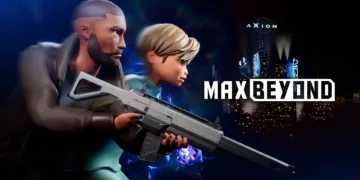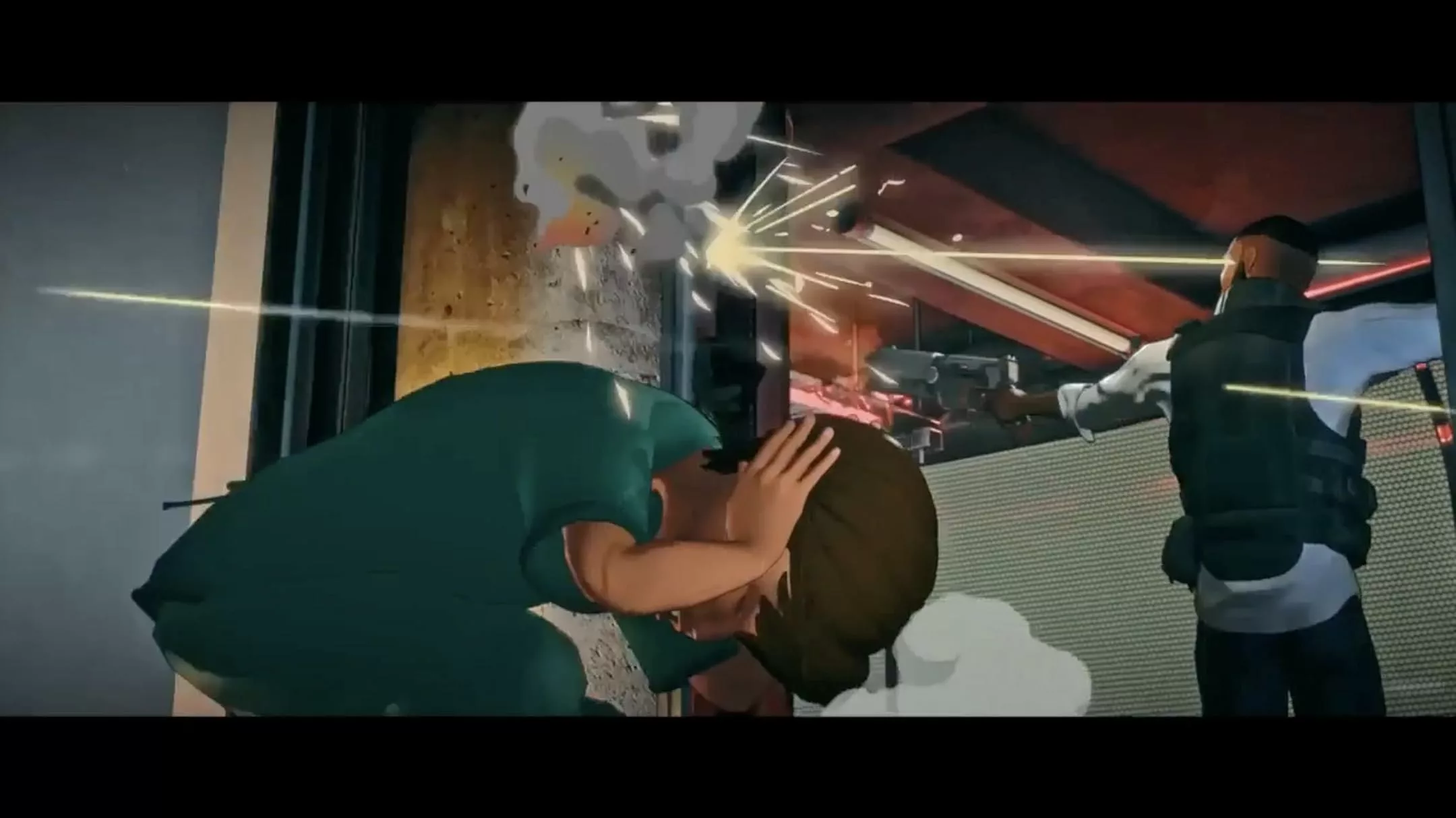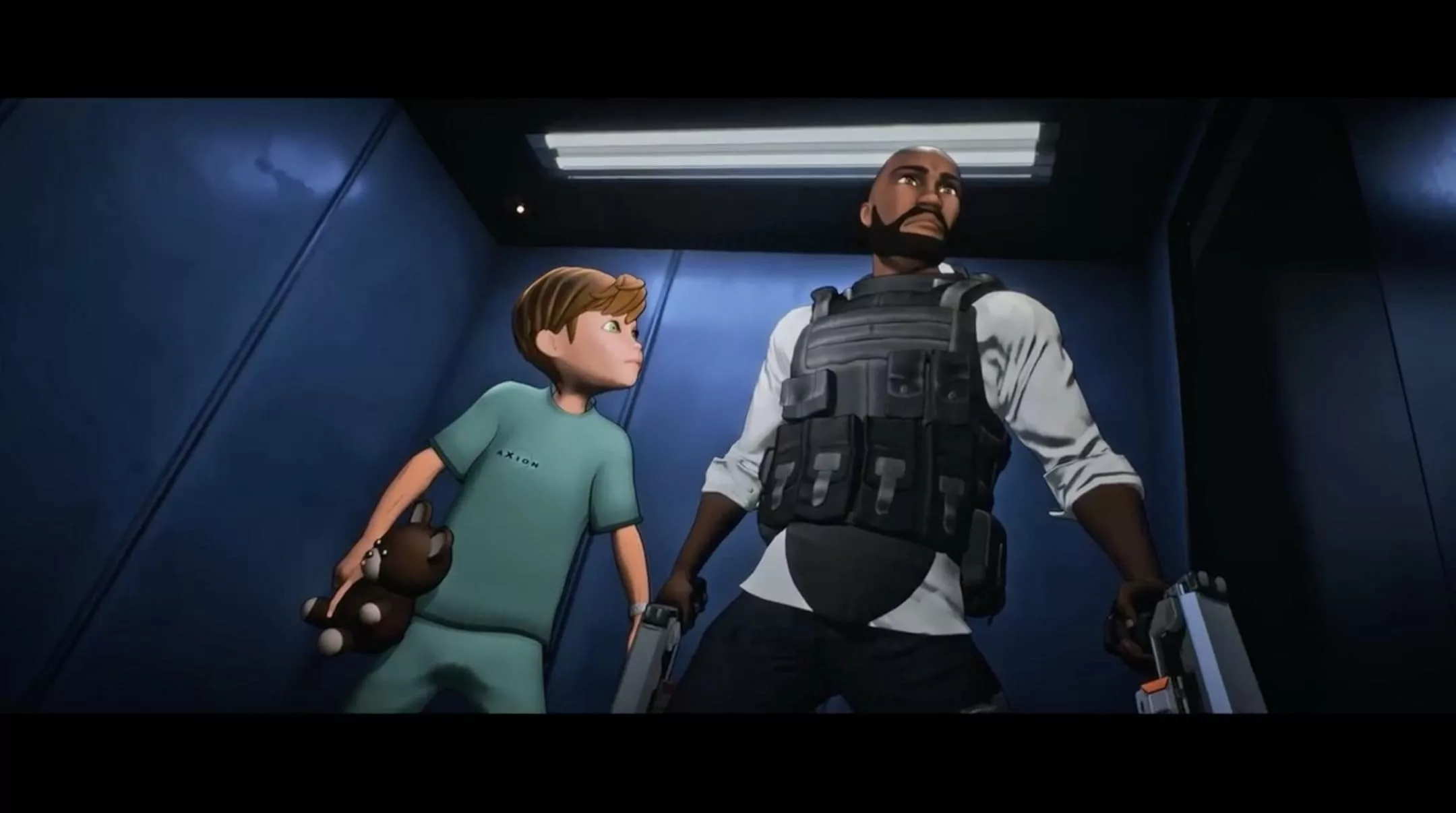Fusing elements of science fiction and family drama, Max Beyond offers an intriguing premise that, in other hands, could have made for quite a compelling feature. As an animated film born of a collaborative effort between director Hasraf Dulull and video game developers looking to build their story and characters, it shows flashes of inventiveness amidst technical troubles that undermine the whole.
Set in a futuristic dystopia controlled by sinister corporations, the film’s central narrative follows brothers Leon and Max Walker as the latter uses powers of teleportation between parallel universes to search for a reality where the former succeeds in rescuing him from captivity. A high-concept plotline with potential for deep philosophical musings on the nature of choice, fate, and what connects us across space and time. Yet inconsistencies in animation quality and an overly repetitive rescue structure keep it from realizing its full vision.
With a larger budget to allow for hiring top animators and time spent refining the script, Max Beyond’s mix of sci-fi action and family drama could have soared. As it stands, one sees in its creative team and story infrastructure the foundations for excellence, simply needing additional development to elevate the finished product to its highest level. For those willing to enjoy what glimpses of brilliance manage to shine through, it remains an incomplete, but not unpromising, undertaking with room left to explore its imaginative corners more fully.
Max Beyond and the Multiverse Mission
The animated sci-fi film Max Beyond wastes little time introducing us to its central concept: that young Max Walker possesses a unique power to open “rifts” between parallel universes. Trapped in a futuristic research facility run by the nefarious Axion Corporation, Max utilizes this ability in a desperate bid to change his fate.
We learn Max and his older brother Leon share a special bond, with the latter vowing to do anything to protect the boy following some past family tragedies. Yet Leon finds himself powerless as Max undergoes mysterious medical experiments within Axion’s tightly secured tower. Sparking protests outside, the facility’s head of research, Dr. Ava Johnson, insists her work will help mankind, while Max grows increasingly anxious.
Each night, the child suffers visions of Leon storming the building in attempts to free him, only to perish against Axion’s cybernetic guards in gruesome new ways. But Max comes to understand that these aren’t dreams—rather, glimpses into alternate realities where each rescue plays out with subtle differences. Empowered by this revelation, Max begins jumping between universes himself, searching for the elusive world where Leon survives.
We follow the brothers across numerous retries, watching as even minor changes like Leon choosing a different weapon completely alter the outcome. Yet failure remains the only constant, with Max’s rifts taking a further toll on his health each time. Dr. Johnson, too, takes notice, introducing her own tweaks, hoping to fracture Max’s will.
As his condition worsens, Max redoubles his efforts to locate the perfect universe. But can he succeed before the rifts consume him entirely? And will Leon ever learn from past mistakes, finding a way to overcome whatever stands between him and saving his beloved brother? The film builds to a climactic finale that offers the only chance of rewriting their destiny once and for all.
The Heroes and Villains of Max Beyond
At the heart of Max Beyond’s adventure across parallel worlds lie three central figures: Max, his protective brother Leon, and the enigmatic Dr. Ava. Each carries their own emotional burdens that shape their actions throughout the film.
Young Max serves as the audience’s guide, possessing a mysterious power to open rifts leading to alternate realities. Still grieving some past family tragedies, the boy simply wants to find safety with Leon. Yet Max gradually gains understanding of his gift, knowing it offers hope to change their doomed fate if used right. What begins as frightened resistance transforms into brave cooperation as Max fully accepts his pivotal role.
Previously a devoted marine, Leon has not adjusted well to civilian life outside the service. Plagued by trauma, he channels all his energy into protecting Max—sometimes to his own detriment. Leon continuously storms the imposing Axion facility through sheer force of will. But repeated failures start chipping at his determination. By the story’s end, though, Leon finally learns there are better ways than violence alone.
Dr. Ava oversees Max’s confinement within Axion’s walls, pursuing her research above all else. At first, she’s the classic ‘evil scientist’, dismissing Max’s humanity. Still, fascinating clues emerge about Ava’s shadowed past as the film progresses. By the climax, her views undergo a shift thanks to Max’s inspiring resilience. Discoveries hint that Ava may yet become an unlikely ally for the brothers.
All three characters undergo meaningful changes spurred by their connections. Max gains courage through affirming life’s beauty; Leon finds hope can outmatch fear; and Ava’s heart thaws due to compassion’s power. Their blended motives and transformations hold deeper lessons about standing together against oppression through nonviolent means. By the story’s end, former enemies even join as friends focused on building a brighter future.
The Sci-Fi World of Max Beyond
While Max Beyond explores some compelling ideas about science, family, and alternate realities, it’s a shame the animation doesn’t fully bring these concepts to life. Produced with Unreal Engine, the visuals just can’t compare to what we expect from modern animated features.
Characters move in stiff, stilted ways, lacking realism. Their features come across as quite basic, and their skin seems almost plastic-like. Action sequences that should thrill instead leave you wanting more fluidity of motion. Emotional moments fall flat since faces display minimal expression. It’s like the animation is stuck moving at only one speed throughout.
Yet the imaginative world portrayed, from the vivid sci-fi cityscapes to mysterious medical facilities and futuristic tech, draws you in. You sense that this storytelling tool limited what might have otherwise been a far richer experience. The Unreal Engine clearly excels more for fast-paced games than translating nuanced performances to film.
But where Max Beyond does shine are its detailed production designs. A wealth of imagination went into crafting this futuristic realm. Towering metallic structures loom over urban landscapes as massive holograms illuminate the smoggy skies. Complex medical equipment and computers immerse you in this society steeped in advanced science. Subtle branding establishes corporate dominance without needing exposition.
While visuals can’t redeem weak storytelling, Max Beyond at least treats viewers to an intricately produced vision of how technology might warp our world. It’s a shame more time wasn’t spent refining animation to match these vividly realized settings. With smoother motion and emotive detail, the experience could have soared to great heights. As it stands, the visuals provide culture while hindering emotional resonance.
With genres like sci-fi relying so heavily on visual storytelling, animation quality remains paramount. The world of Max Beyond tantalizes, yet leaves you wanting the technical feats to fully bring its experimental concepts to life. Perhaps future innovations can realize their futurist visions in a way that engages the heart and mind.
Futures Within Futures
Max Beyond takes viewers on a thought-provoking journey through parallel worlds. At its core lies a powerful bond between two brothers and one boy’s mysterious ability to shift between multiple timelines. But delving deeper reveals thoughtful musings on the human impacts of science and corporate interests.
The film introduces futuristic concepts like a multiverse in approachable, imaginative ways. Max finds himself in an endless loop, forever trying to change his destiny. His gift allows glimpses into “what if” scenarios, from major divergences to subtle butterflies. It raises fascinating questions around free will and controlling fate across infinite paths.
Yet these possibilities come at great risk. Each jump strains Max’s health and soul. The story serves as a cautionary tale: while technology may reveal new frontiers, are we ready for its true costs? Max’s captors see only data, not a child’s suffering. Their experiments risk tearing apart what family he has left.
Subtly, Max Beyond asks us to consider the future. As science pushes boundaries, what lines should not be crossed regarding human subjects? When does progress become purely profit-driven, with people as mere commodities? Leon’s quest highlights both the glory and fallibility of those who fight for others’ freedom. His determination shows his power in refusing to accept the status quo’s injustices.
Layered beneath visceral action lie thoughtful meditations on corporate dominance, government overreach, and individual agency against vast systems. Max’s inner battles resonate on wider scales. While raising many questions, the film leaves answers open; as with life, uncertainties often far outweigh clear solutions. Some issues will always remain works in progress, much like the futuristic worlds within the story.
Max Beyond transports viewers, if only briefly, to magnificent vistas of what may come. But its most enduring impact is sparking imagination and reflection on navigating futures within our control and those beyond any one person’s power to rewrite. Some challenges must be faced one shift at a time.
Alternate Realities, Endless Possibilities
Max Beyond takes viewers on a uniquely structured sci-fi journey. We follow Max as he shifts between parallel worlds, forever trapped in a “Groundhog Day” loop of rescue attempts. At first, the concept proves intriguing: how will one boy rewrite his destiny?
But repetition becomes the film’s downfall. In each reality, Leon valiantly fights to save Max. And in each, he meets the same fate. Various details change, but the result stays constant, making actions feel meaningless. While exploring infinite timelines sounds endlessly fascinating, Max Beyond fails to evolve the premise.
Pacing worsens the issue. Generous action opens on a high note. But as rescues continually fail without progress, energy falters. Subtle world variations lose potency when we know the dreary endpoint. More time spent developing Max’s plight and expanding his captors’ motives could have offset the monotony.
Curiously, resolution arrives via a sudden introduction of stakes largely absent earlier. After growing numb to resets, urgency emerges too late to reinvigorate. The conclusion also raises more questions than it answers, another missed opportunity for insight.
Max Beyond holds seeds of compelling sci-fi grounded in familial love. But the constraints of its format prove an artistic straightjacket. While parallels between games and films offer possibilities, the translation loses meaning through repetitive beats. Interweaving perspectives or expanding scope could have spun narratives into new threads, maintaining momentum across shifting landscapes.
As is, the premise proves greater than one execution. But perhaps another tale may tap more of alternate realities’ endless creative fuel. When we change, one thing is for sure: who knows how far ripples could take the story.
Rifts, Rescues, and Repeats: An Uneven Sci-Fi Adventure
Hasraf Dulull’s Max Beyond takes viewers on a journey through parallel worlds. At its core lies a moving story of brotherly love, as war veteran Leon refuses to stop rescuing young Max. Their bond keeps audiences invested through Max’s “groundhog day” resets between dimensions.
Yet execution holds the film back. Its Unreal Engine animation feels stiff, leaving emotive moments flat. Repetitive rescues also diminish impact, with weariness replacing intrigue. While unique concepts like medical experimentation and corporate oppression tease deeper exploration, the film stays surface-level.
Nor does Max Beyond truly break new narrative ground. Familiar dystopian and multiverse tropes predominate without challenging perspectives. The plot relies on clichés where fresh angles could have distinguished the tale. Pacing too suffers as a result, with energy waning where risk and revelation were needed.
However, Dilull shows promise in crafting imaginative sci-fi worlds. And the brother’s relationship, hinting at past trauma, offers room for richer character arcs. A revised approach blending refinement and risk-taking could realize this story’s potential.
For genre fans, Max Beyond presents an enjoyable, if flawed, sci-fi adventure. But technical limitations and a lack of innovation restrict its broader appeal. While its heart lies in rewarding concepts, one hopes the in-development game harnesses multiverse mythos and meaningful family bonds more compellingly. For Dilull, this first foray opens doors to higher cinematic achievements.
The Review
Max Beyond
Max Beyond presents an entertaining premise marred by technical flaws and a failure to evolve its familiar concepts into a fully engaging narrative. While the bond between Max and Leon engages viewers, repetitive rescues and flat animation diminish the emotional impact. However, Dilull demonstrates skill in crafting imaginative sci-fi worlds, and the foundations of character and story offer room for richer future tales.
PROS
- Interesting premise exploring multiverse theory and family bonds
- Concepts like corporate oppression and experimental children hint at depth.
- Imaginative sci-fi worlds show promise for directors's visionary abilities.
- The central relationship between Max and Leon engages viewers.
CONS
- The repetitive "groundhog day" plot structure becomes dull and predictable.
- Technical flaws like stiff animation hurt emotional story beats.
- Fails to develop clichéd dystopian and multiverse tropes into fresh insights
- Low production values diminish entertainment value





















































